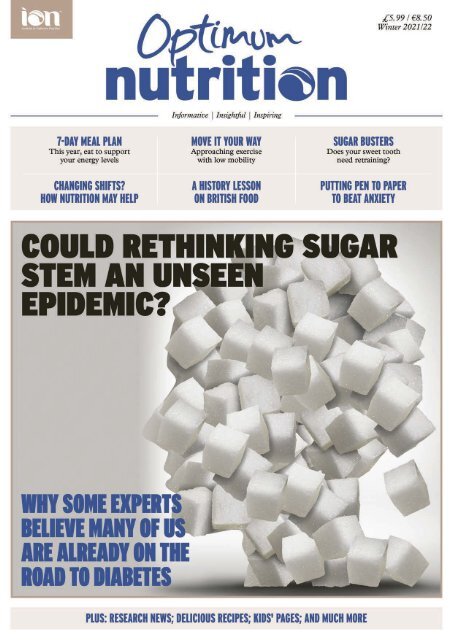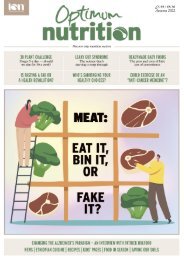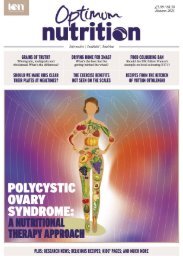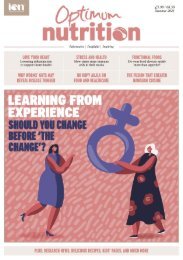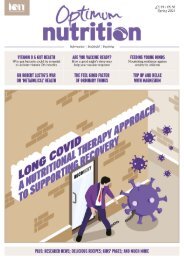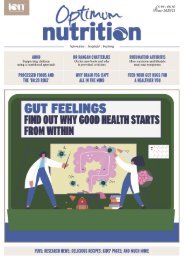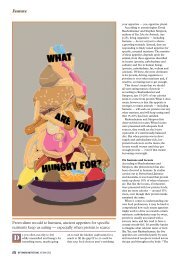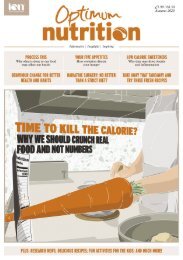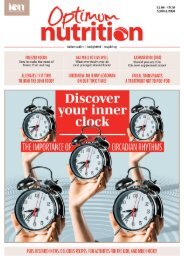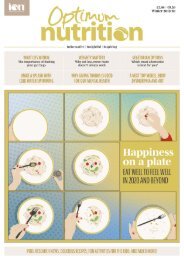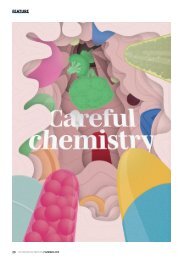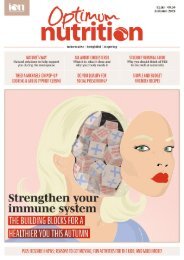Optimum Nutrition - Winter 2021 - PREVIEW
Why rethinking sugar and focusing on insulin resistance could stem an unseen epidemic | A 7-day energy supporting meal plan from registered nutritional therapist Catherine Jeans | Dr Megan Rossi answers questions on gut health and shares recipes from her new book Eat More, Live Well | Sustainable ways to retrain a sweet tooth | Plus research news, recipes, educational kids' pages and much more!
Why rethinking sugar and focusing on insulin resistance could stem an unseen epidemic | A 7-day energy supporting meal plan from registered nutritional therapist Catherine Jeans | Dr Megan Rossi answers questions on gut health and shares recipes from her new book Eat More, Live Well | Sustainable ways to retrain a sweet tooth | Plus research news, recipes, educational kids' pages and much more!
You also want an ePaper? Increase the reach of your titles
YUMPU automatically turns print PDFs into web optimized ePapers that Google loves.
IN THIS ISSUE<br />
08<br />
COULD RETHINKING SUGAR STEM AN UNSEEN EPIDEMIC?<br />
Alice Ball finds out why some experts believe an unseen epidemic of insulin resistance is driving obesity and disease. On p13,<br />
Catherine Morgan reflects on early morning blood sugar spikes from an ‘iced latte’ habit<br />
14 SEVEN DAY MENU<br />
17 INTERVIEW<br />
20<br />
Start the year with an energy supporting<br />
7-day meal plan from registered<br />
nutritional therapist Catherine Jeans<br />
22<br />
FEATURE<br />
Dr Megan Rossi answers questions on<br />
gut health and shares recipes from her<br />
new book Eat More, Live Well<br />
30<br />
ON YOUR PLATE<br />
Three warming “wok to wonderful”<br />
recipes from The Noodle Cookbook by<br />
Damien Lee<br />
38<br />
KITCHEN CHEMISTRY<br />
Elettra Scrivo looks at why cooking<br />
methods and food pairings can affect<br />
how food impacts our blood sugars<br />
Food historian Dr Annie Gray talks to<br />
Alice Ball about the highs and lows of<br />
British food through time<br />
ALL ABOUT<br />
Travelling or changing shifts, our body<br />
clock bears the brunt. Louise Wates<br />
looks at whether nutrition can help<br />
STORECUPBOARD HERO<br />
Nutritious and versatile, chickpeas<br />
are a handy staple — and not just for<br />
hummus. Judith Orrick writes<br />
44 FOOD FACT FILE<br />
MOVE IT<br />
50<br />
White, milk, dark or raw? Alice Ball<br />
weighs up the potential benefits of<br />
chocolate for our health<br />
24<br />
33<br />
39<br />
IN SEASON<br />
Try a leek & pumpkin rosti recipe and<br />
discover why leeks can be a nutritious<br />
addition to everyday cooking<br />
48<br />
If low mobility gets in the way of<br />
exercise, there can be other ways to get<br />
fi t . Alice Ball writes<br />
FEATURE<br />
04 COMMENT & NEWS | 26 KIDS’ PAGES | 34 FROM ION | 40 BOOK THERAPY | 47 QUIZ<br />
Quitting sugar isn’t easy with a sweet<br />
tooth. Alice Ball finds sustainable ways<br />
to retrain our taste buds<br />
28<br />
LITTLE LIVES<br />
If your child doesn’t eat meat, can<br />
traditional diets offer inspiration beyond<br />
readymade veggie bangers and burgers?<br />
36<br />
DIFFERENT STROKES<br />
Best selling author CJ Daugherty tells<br />
Louise Wates how writing helped her<br />
deal with stress and anxiety<br />
42<br />
WORLD CUISINE<br />
Whether served on a banana leaf<br />
or plate, an Indian thali offers taste<br />
sensations, from sweet to sour<br />
GRADUATE STORY<br />
Why, after gaining a PhD in public<br />
health, Dr Kirstie Lawton decided to<br />
study nutritional therapy at ION<br />
OPTIMUM NUTRITION | WINTER <strong>2021</strong>/22<br />
3
Feature<br />
IS INSULIN RESISTANCE<br />
THE HIDDEN EPIDEMIC<br />
DRIVING MODERN DAY<br />
DISEASE?<br />
Image: Lightwise © 123rf.com<br />
Could focusing on how food affects our blood sugars — even when we aren't diabetic — be key<br />
to beating chronic disease as well as obesity? Alice Ball writes<br />
“<br />
I<br />
nsulin resistance is the epidemic<br />
you’ve never heard of,” writes<br />
scientist and researcher<br />
Benjamin Bikman, PhD, in his <strong>2021</strong><br />
book Why We Get Sick. And he could be<br />
right; because with another New Year<br />
behind us, how many of us — without<br />
understanding the role that insulin plays<br />
in obesity — will once again succumb to<br />
the prevailing narrative that if we just eat<br />
less and move more, the post-Christmas<br />
weight gain will take care of itself?<br />
8 OPTIMUM NUTRITION | WINTER <strong>2021</strong>/22
Feature<br />
IN BRIEF<br />
• Research suggests insulin<br />
resistance rather than overeating is<br />
the primary cause of obesity.<br />
• Insulin resistance can also be<br />
driven by stress and poor sleep.<br />
• Insulin resistance drives chronic<br />
diseases including heart disease,<br />
dementia and type 2 diabetes.<br />
• A low carb diet can support insulin<br />
sensitivity and reverse type 2<br />
diabetes in some instances.<br />
• Glucose tolerance (i.e. the amount<br />
of carbohydrate your body can<br />
handle) varies between individuals.<br />
Growing evidence suggests that our<br />
bodies do not act like bank accounts<br />
for calories. One recent paper,<br />
published in the American Journal of<br />
Clinical <strong>Nutrition</strong>, suggests that insulin<br />
resistance, rather than overeating, is<br />
the primary cause of obesity. It also<br />
lays the blame for obesity on excessive<br />
consumption of foods with a high<br />
glycaemic load (GL); in other words,<br />
rapidly digestible carbohydrates. These<br />
foods, the researchers propose, cause<br />
changes to the hormone insulin, which<br />
changes metabolism, and drives fat<br />
storage, weight gain and obesity. 1<br />
So this January, rather than focusing<br />
on how much we’re eating, could<br />
focusing on what we’re eating and how<br />
it affects our insulin be the key to losing<br />
weight?<br />
Lock and key<br />
Insulin is a vital hormone, with the<br />
essential job of getting rid of sugar in<br />
our bloodstream after we eat. Think of<br />
it like a lock and key mechanism. Sugar<br />
(glucose) in the blood is trying to get<br />
through the door of the cell. But to get<br />
inside, it must have a key to open that<br />
door. Insulin is that key.<br />
But what happens if you have too<br />
much sugar in your bloodstream? Then,<br />
the doors of the cell become resistant<br />
to the insulin — think of the keyhole<br />
getting rusty through over-use. This<br />
means that the pancreas has to pump<br />
out more insulin to try to get the cells to<br />
unlock, thus elevating levels of insulin.<br />
Excess sugar can also get pushed<br />
into belly fat and the liver. The latter<br />
is what’s known as non-alcoholic fatty<br />
liver disease (NAFLD); a condition<br />
that affects around a quarter of<br />
the developed world. NAFLD also<br />
interferes with the action of insulin<br />
itself, which means the pancreas has to<br />
produce even more insulin to get rid of<br />
all the sugar from your blood.<br />
Insulin acts as a key for opening cells to store glucose away as energy (left); when cells<br />
become 'insulin resistant', glucose remains in the blood, raising blood sugars (right)<br />
Insulin resistance can be considered<br />
a spectrum as, over time, more and<br />
more cells become resistant to insulin.<br />
Eventually, the pancreas gets worn out<br />
and can no longer produce enough<br />
insulin to overcome the cells’ resistance.<br />
The result is type 2 diabetes.<br />
The driver of disease<br />
Whilst not all of us might be diagnosed<br />
as diabetic, Bikman’s book raises the<br />
question as to whether many of us are<br />
somewhere on this insulin resistant<br />
spectrum, and that this is driving<br />
chronic disease.<br />
“People don’t die from insulin<br />
resistance,” Bikman tells <strong>Optimum</strong><br />
<strong>Nutrition</strong>. “They die from the diseases<br />
that insulin resistance is causing.<br />
Alzheimer’s disease, heart disease; those<br />
are the complications that are arising<br />
from the insulin resistance, which<br />
ultimately prove lethal.”<br />
When it comes to heart health, for<br />
example, Bikman says that insulin<br />
resistance promotes higher blood<br />
pressure. “It does this through several<br />
different mechanisms. One is forcing<br />
the kidneys to hold onto more salt than<br />
normal, which means they’re forced to<br />
hold onto more water as well. And if<br />
they’re holding onto more water, blood<br />
pressure starts to climb.”<br />
Insulin also helps to promote the<br />
dilation of our blood vessels, he adds.<br />
However, when the blood vessels<br />
become insulin resistant, they stay<br />
constricted and can’t move as much<br />
blood as they did before, causing blood<br />
pressure to increase.<br />
“People don’t die from insulin resistance…They die from the diseases<br />
that insulin resistance is causing…"<br />
Image: Elyomys © 123rf.com<br />
Image: Simpson33 © 123rf.com<br />
OPTIMUM NUTRITION | WINTER <strong>2021</strong>/22<br />
9
Interview<br />
HISTORIAN ANNIE GRAY<br />
DELIVERS A LESSON ON<br />
BRITISH FOOD<br />
Food historian and Radio 4 regular Dr Annie Gray talks to Alice Ball about why the current<br />
adage to ‘eat what your great grandmother ate’ for healthier nutrition may, in fact, be misguided<br />
Y<br />
ou may have heard experts<br />
say: ‘Don’t eat anything your<br />
great-grandmother wouldn’t<br />
recognise as food’, but Dr Annie Gray<br />
(PhD) isn’t so convinced. According<br />
to the food historian, eat how your<br />
ancestors ate and you could end up<br />
with gout — an arthritic condition<br />
considered something of a “disease de<br />
jour” in the 18th century.<br />
“People romanticise the past,” she<br />
says over a video call. “They think we<br />
all lived in harmony with everything,<br />
but they forget that the diet of the poor<br />
was awful — and in many ways, the diet<br />
of the rich was too.”<br />
The 19th century is another case<br />
in point. “You’ve got the poor reliant<br />
upon bread,” she says. “That in itself<br />
isn’t that bad — a good loaf of bread is<br />
pretty good for you — but the trouble<br />
is the bread wasn’t good quality. It was<br />
always made from white flour, which<br />
has got the wheat germ taken out, and<br />
then if you’re dirt poor you’re probably<br />
putting sweetened condensed milk on it<br />
which is largely just sugar.”<br />
Malnutrition also takes many forms,<br />
she says. “You can be malnourished<br />
in the 19th century and it will show<br />
OPTIMUM NUTRITION | WINTER <strong>2021</strong>/22<br />
17
Interview<br />
Image: Rrraven © 123rf.com<br />
because you’re incredibly thin and<br />
you’re not getting the nutrients you<br />
need, or you can be malnourished<br />
in the 21st century and be grossly<br />
overweight. Those two are just two sides<br />
of the same coin.”<br />
Gray, a broadcaster, writer and cook,<br />
has specialised in the history of food<br />
and dining in Britain for more than a<br />
decade, focusing on the 17th century<br />
onwards. You name it, she’s eaten it;<br />
from kangaroo brain cakes (“tasted<br />
a bit like spam, to be honest”) to an<br />
“epic” boar’s head during a Tudor<br />
feast. Since 2012, she’s been a regular<br />
panellist on BBC Radio 4’s The Kitchen<br />
Cabinet, and her latest book of the same<br />
name (fully titled The Kitchen Cabinet:<br />
A Year of Recipes, Flavours, Facts, &<br />
Stories for Food Lovers), which delves<br />
into Britain’s culinary past and present,<br />
was published in September <strong>2021</strong>.<br />
So she is perhaps well qualified to<br />
declare that insults thrown at British<br />
cuisine (or, perhaps, Britain’s lack of<br />
cuisine) are “total baloney”.<br />
“Britain has a really good food<br />
heritage both in terms of British dishes<br />
— roast meat, fish and chips, and pork<br />
pie — and our own food culture going<br />
backwards,” she says. “Yes, French<br />
cuisine was what ruled the roost in<br />
terms of the aristocracy for much of the<br />
past 500 years, but that was true right<br />
across the world — certainly among<br />
English speaking and European areas.”<br />
She does, however, believe that<br />
British food suffered after the Second<br />
World War — another reason why<br />
modelling your grand- or greatgrandmother’s<br />
diet mightn’t be the best<br />
approach.<br />
“I think a lot of people don’t realise<br />
that during the war, rationing was bad.<br />
But after the war it became worse,” she<br />
says. “And when you think about kids<br />
growing up, you’re eight when the war<br />
breaks up, but you’re probably married<br />
“I think a lot of people don’t<br />
realise that during the war,<br />
rationing was bad...but after<br />
the war, it became worse...”<br />
“We’ve both reduced the number of things we eat, but also in<br />
some ways we’ve got too much variety in others. You can get 20<br />
different varieties of pasta or five different types of ketchup...”<br />
with kids by the time rationing ends.<br />
That chance to learn, that transition<br />
of knowledge [about good food], isn’t<br />
really there.”<br />
It’s perhaps an ironic statement,<br />
considering that during her own<br />
teenage years, Gray survived on<br />
microwave meals. “My mother really<br />
couldn’t cook and my dad sort of<br />
could, but it was classic 1980’s family<br />
fare,” she says.<br />
This changed when the family moved<br />
to France during her A-levels, and Gray<br />
boarded with a French family. “It’s<br />
a bit of a cliché, but it was this total<br />
epiphany where I suddenly realised that<br />
food could be incredible.<br />
“My mother’s omelettes were always<br />
awful — you could bounce them off<br />
the ceiling. But I had one in France<br />
and was like ‘This isn’t an omelette’,<br />
because it was cooked in so much<br />
butter and unbelievably good.<br />
“I think it was at that point I realised<br />
if you’re going to eat three times a<br />
day, you should make it count.” At the<br />
University of Oxford, where she studied<br />
modern history, she was “the person<br />
who was roasting pheasant and making<br />
[her] own pasta”, despite a lack of<br />
cooking facilities.<br />
Yet after graduating, she still had no<br />
idea what she wanted to do and ended<br />
up “getting sacked from basically every<br />
job”.<br />
“I decided I would go back and do<br />
a masters [in historical archaeology]<br />
because I still loved history,” she says.<br />
“Then I left, got sacked a few more<br />
times and did a PhD. By this time I<br />
knew I wanted to study food and I<br />
knew I wanted to work with museums.<br />
The PhD allowed me to do those<br />
things.”<br />
“Greater choice…all an illusion”<br />
According to Gray, one of the biggest<br />
differences between historic and<br />
modern day diets is the variety of<br />
what we eat. With advances in trade,<br />
technology and travel, it can often<br />
appear like we have greater choice over<br />
our diets. But this, she says, is “all an<br />
illusion”.<br />
“There were 3,000 varieties of apples<br />
in the Victorian era, but today you walk<br />
into the average supermarket and get<br />
five, and they’re all enzyme treated.<br />
“We’ve both reduced the number<br />
of things that we eat, but also in some<br />
ways we’ve got too much variety in<br />
others. You can get 20 different varieties<br />
of pasta or five different types of tomato<br />
ketchup.”<br />
Certain vegetables have also<br />
disappeared from modern day diets<br />
completely; skirret (a root vegetable),<br />
scorzonera (similar to parsnip) and<br />
salsify (a root vegetable with an oysterlike<br />
taste).<br />
Jerusalem artichokes, which are<br />
beneficial for gut health, were also<br />
eaten habitually, and when it came to<br />
meat, every part of the animal would be<br />
eaten.<br />
Yet meat was “very much for the<br />
rich”. Historical cookbooks tend to<br />
draw attention to meat consumption,<br />
but this is only because the “food that<br />
gets the publicity is the stuff the rich<br />
ate”, she says.<br />
“We get this skewed idea that<br />
everybody ate loads of meat, very<br />
plainly done with some vegetables on<br />
Image: Torky © 123rf.com<br />
18 OPTIMUM NUTRITION | WINTER <strong>2021</strong>/22
World Cuisine<br />
cooking techniques and spices that also<br />
set them apart. For example, cooking<br />
with fennel and black pepper in Tamil<br />
cooking dates back centuries as both are<br />
locally grown.<br />
“When we think of Andhra Pradesh,<br />
the misconception of the local food<br />
being searingly hot couldn’t be [further]<br />
from the truth. My favourites are the<br />
Andhra lamb chops curry with tamarind<br />
and ginger, from the lamb chapter in<br />
Thali, and also an Andhra thali which<br />
gives an insight into how the food from<br />
this region is diverse, full of flavour and<br />
simple to cook.”<br />
KERALA FISH MOILEE (CLASSIC COCONUT FISH CURRY)<br />
Maunika says:<br />
“A classic fish curry with chilli, pepper,<br />
curry leaves and turmeric simmered<br />
in coconut milk, this southern Indian<br />
fish curry is a staple in every household<br />
because it is so simple to cook. I like to<br />
serve it with rice and cucumber salad.<br />
Ask your fishmonger to cut the fish into<br />
steaks, as they will do it expertly and<br />
ensure that the steaks still hold together<br />
with the help of a central bone.”<br />
Ingredients<br />
• 1 tsp ground turmeric<br />
• Pinch of salt<br />
• Juice of ½ lime<br />
• 600g cod, monkfish or sea bass, cut<br />
into 3.5cm steaks<br />
• 60g white onion, roughly chopped<br />
• 4 cm ginger root, roughly chopped<br />
• 4 garlic cloves, roughly chopped<br />
• 2 tbsp oil<br />
• 1 tsp black mustard seeds<br />
• 5 green cardamom pods, whole<br />
• 2 green chillies, slit lengthways<br />
• 5–7 curry leaves<br />
• 100ml water<br />
• ½ tsp sugar<br />
• Salt, to taste<br />
• 400ml coconut milk<br />
• 1 heaped tsp tamarind paste<br />
• ½ tsp freshly ground black pepper<br />
• Coriander<br />
For the garnish<br />
• 2 tbsp chopped coriander leaves<br />
Method<br />
Mix ½ tsp of the ground turmeric,<br />
with the salt and lime juice, rub into<br />
the fish steaks, then set aside. Add the<br />
onion, ginger and garlic to a blender<br />
and blend to a smooth fine paste with<br />
a splash of water. Set aside.<br />
Heat the oil in a heavy-based, nonstick<br />
saucepan over a medium heat.<br />
Add the mustard seeds and as they<br />
begin to sputter, work quickly to add<br />
the cardamom pods, green chillies<br />
and curry leaves. Add the onion,<br />
ginger and garlic paste and fry for 1–2<br />
mins, then add the remaining ground<br />
turmeric, along with the water, sugar<br />
and salt. Mix well, then simmer for 1<br />
min.<br />
Reduce the heat to low, then add<br />
the fish steaks and let them cook for<br />
a further minute. Add the coconut<br />
milk, cover and simmer gently for<br />
4–5 mins until the fish is moist and<br />
cooked through. Give the pan a gentle<br />
swirl a couple of times to make sure<br />
everything is mixed but the fish pieces<br />
don’t break up.<br />
Add the tamarind, black pepper<br />
and fresh coriander and stir well,<br />
simmering for 1 min. Serve with plain<br />
basmati rice and a cucumber salad.<br />
<strong>Optimum</strong> <strong>Nutrition</strong> tip:<br />
Try using ghee or coconut oil instead<br />
of vegetable oil, and swap white rice<br />
for wholegrain or cauliflower rice.<br />
How important is nutrition when<br />
serving a thali?<br />
“A lot of what gets served over a thali<br />
includes pulses, grains, dairy and even<br />
fresh fruit — ingredients that are high<br />
in protein, carbohydrates and rich in<br />
vitamins…<br />
“Thalis are a complete meal<br />
experience and brimming with<br />
vegetables, lentils, wholemeal breads and<br />
aromatic curries that bring warmth and<br />
flavour to our meals.”<br />
Recipe reproduced with<br />
kind permission.<br />
Extracted from Thali by<br />
Maunika Gowardhan,<br />
Hardie Grant Books.<br />
OPTIMUM NUTRITION | WINTER <strong>2021</strong>/22<br />
43
Food for thought:<br />
Eat to support mental wellbeing<br />
Watch our free, bite-sized videos by vising ion.ac.uk/ONmentalwellbeing<br />
When it comes to supporng our mental wellbeing, evidence-informed advice on nutrion can be an<br />
important and posive step.<br />
Our colleagues at the Brain Bio Centre, part of the Instute for Opmum Nutrion’s nutrional therapy<br />
clinic, share praccal ps to get you thinking about the link between food and mood.<br />
Watch our free videos now to discover how food and nutrion can support you and your loved ones.<br />
Get started for free at ion.ac.uk/ONmentalwellbeing<br />
www.ion.ac.uk | info@ion.ac.uk | 020 8614 7800 | instuteforopmumnutrion | @ion_nutrion | @ion_nutrion<br />
*Costs are for a UK based subscripon. Cost for EU based subscripon is £34.00 and cost for Rest of World based subscripon is £46.00<br />
Instute for Opmum Nutrion is an independent educaonal charity. Registered company number 2724405, registered charity number 1013084


